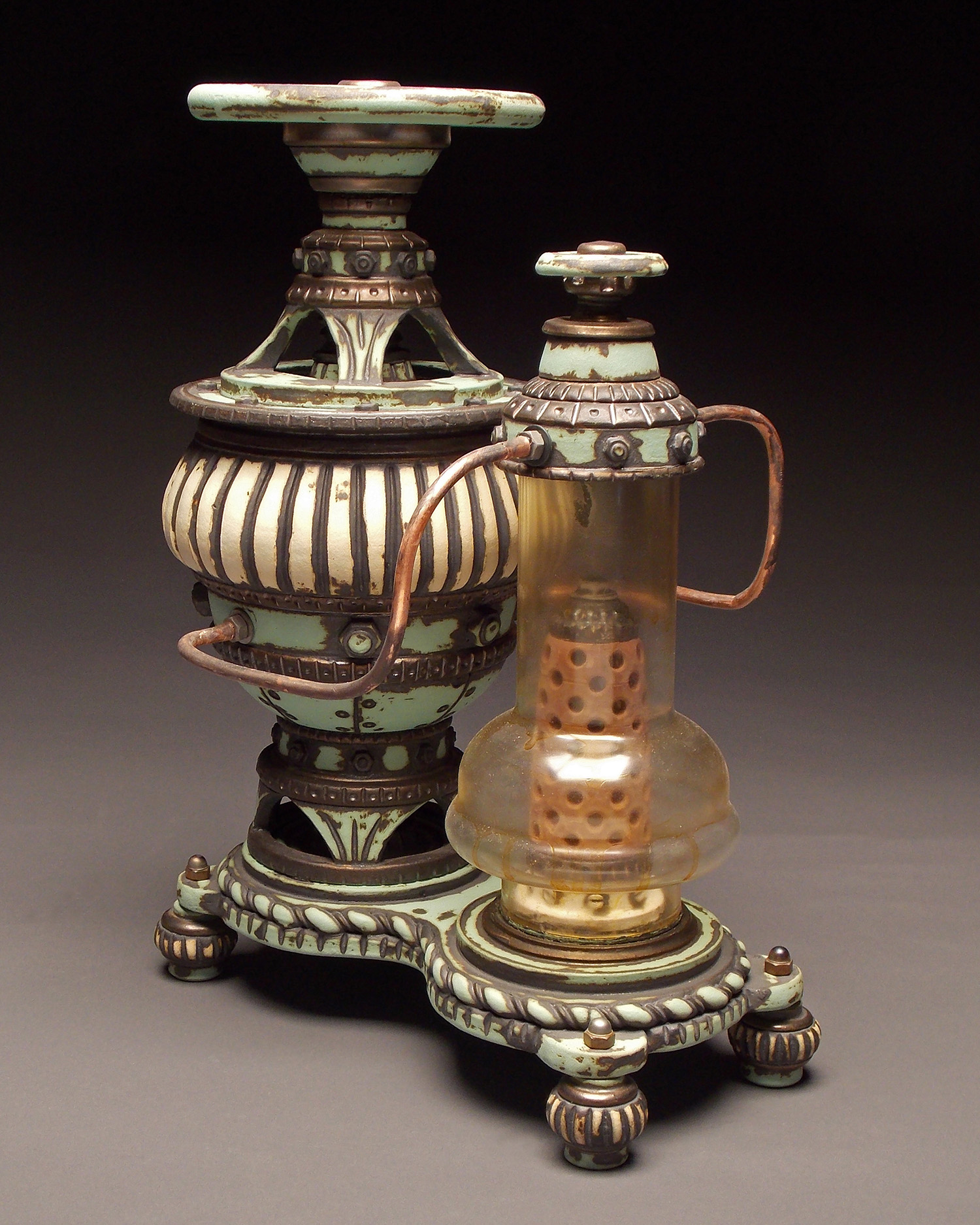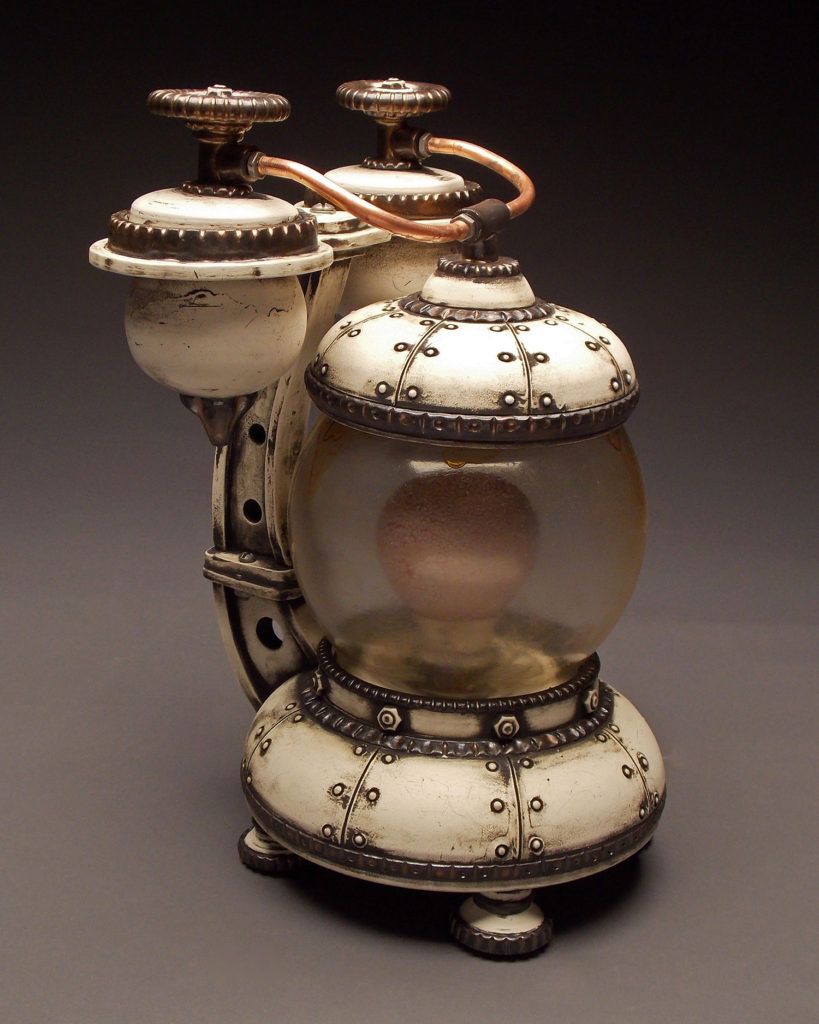More Than Meets the Eye

Writer Amanda Christmann
Photography Courtesy of Lanning,
A Bryant Nagel Gallery
[dropcap]A[/dropcap]rt is an illusion for ceramics artist Todd Volz. Upon first glance, what appears to be steampunk-style creations are, from Volz’s hands, something entirely different.
Like steampunk art, Volz’s work is inspired by the post-industrial age, but gone are the moving parts, functional gears and science lab odds and ends of classic steampunk art and fashion. They are replaced by clay, wood, metal and fabric, carefully constructed to look exactly like something they are not—and a little bit like something that has never existed.
“I create ceramic sculptures and functional objects that resemble obscure mechanical devices from our industrial past,” he explains. “A lot of people have said my work has a steampunk aesthetic, but that’s not something I necessarily agree with. I’m not sure I relate to art that way, but obviously, there is a similarity in things [steampunk artists and I] both appreciate.”
Volz, with his long, brown-red beard and rimmed glasses, looks every bit the part of an artist as he sits atop a stool in an office at University of Wyoming. Now a Colorado resident, he is teaching here during a sabbatical placement. In addition to passing along techniques and philosophies to aspiring students, he’s experiencing a bit of a homecoming.
A native of the tiny town of Wheatland, Wyoming, where the most current census still counts fewer than 4,000 people, Volz was raised with an appreciation for hard work and recognizing the slowly turning cycle that connects people, nature and history.
Those ingrained memories come out each time he spends hours creating rivets or screws in clay, or covers his work with a patina that adds years of perceived history to a newly-fired piece of clay.
“I grew up in a small town in Wyoming,” he explains. “My family didn’t farm, but I grew up around agriculture. I worked on farms, and in high school I liked to work on old crappy cars.
“I have memories of being in my dad’s workshop with all the little glass jars of bolts and washers and things lined up on the shelves. Those things interested me when I was growing up, and something about them still interests me today.”
Today, he recreates those tiny moving parts and others, casting them in ceramic and giving them an aged metal-like patina that fools the eye into believing that he’s created something that could actually work. They’re inventive and whimsical, and much more than meets the eye.
His work is often so convincing that people search for elusive “on” switches, and turn them about in their hands taking guesses as to what they actually do.
These moments bring Volz the greatest satisfaction. It’s all about the dichotomy of the recognizable versus the unfamiliar—fact versus fantasy.
“Anything that looks like it’s riveted or metal—it’s always clay,” he says. “I’m thinking more of trying to bring out the idea of history, and to make people think backward in time.”
In today’s world, the functionality of something may not be obvious at first glance. Had one never seen an iPhone, for example, it would be difficult to equate it to a telephone. An uncharged iPad would have little resemblance to a fountain pen, a typewriter, or anything else that has been used to compose letters or other written communication.
In the past, however, whether it was a piece of manufacturing equipment during the Industrial Revolution or a Victrola phonograph, the purpose of just about anything was relatively conspicuous.
Volz’s work is an homage to that era, yet the reality is that, in his process of creating something that appears functional, there is no functionality.
At the same time, from Volz’s imagination come mechanical-looking pieces and parts that appear to be familiar, yet even if they were real, their function would be ambiguous.
It’s the unspoken question marks (or sometimes the spoken questions) that make him smile.
This master of artful disguise is finding that he has room to both evolve, and to return to his own past for inspiration.
“Teaching has been interesting here,” he says. “Coming back to Wyoming, it’s back to wood-fired pottery, soda-fired pottery—I’m back to my roots.”
From the Beginning
“In high school, I had an elective choice of either music or art,” Volz says with a laugh. “That’s what you have in a small town—music or art. I decided it would be an art class.”
He fell in love with his ability to express himself artistically, but coming from a salt-of-the-earth upbringing, he didn’t imagine that art could be his vocation.
“I graduated as salutatorian of my class with a good GPA, so I did pretty well in high school, but college was an entirely different league.
“In college, I went thinking I would do something like pharmacy—something that would make me some money. I had to take art as a general survey class, and when I did, it was the one thing that I thought was something I could get into.”
And so he did.
He earned his bachelor’s degree in art education from University of Wyoming, and went on to earn his master’s degree from University of Idaho.
“Early on in graduate school, I was doing the same thing I had been doing as an undergrad—referencing natural, organic surfaces,” he says. “I began working on pedestal displays, building big pots and making them sort of sit into these wood structures I was creating. On one particular structure, I tried to use threaded rods and bolts, and I really liked the look of it.”
In some ways, it was a throwback to his early days, in the shop with his dad, when he’d been fascinated by the jars of odds and ends that sat neatly arranged on the shelves above the workbench.
“I decided then that that’s what I’m interested in,” he says. “That’s what I want to create.”
A Continuum of Art
Volz has enjoyed both teaching and honing his craft for two decades now, earning acclaim in his field and helping young ceramics artists hone their craft and find their artistic voices.
He’s also learned a bit about himself, infusing the energy and emotion from events that have occurred in his life into his ceramics and pottery.
The names of his pieces, intended to resemble serial numbers, derive from encoded messages and dates that only he knows. Sometimes they represent watershed moments in his life; at other times, they represent a feeling or memory he experienced.
Either way, he isn’t keen on sharing most of those meanings, not because he’s secretive, but because he wants the viewer to attach their own interpretations and ideas to his work.
Today, Volz is still hard at work in the studio, not only creating intriguing faux-functional pieces, but also large wall art and pottery. Both aspects of his art have allowed him to explore new expressions and to engage in new perspectives.
“I feel like, early on, it was just about figuring out the technical aspects of things. I’ve always appreciated the aesthetics, but back then it was more about figuring out how to do everything. My technical skills have developed, and now it’s easier to think about imbuing my work with narrative and meaning.”
Volz’s ceramics were on display at Northern Arizona University throughout the spring in an exhibition called Circuitous. Currently, several of his pieces are available at Lanning, a Bryant Nagel Gallery in Sedona, where he has already begun to earn his share of admirers who, like Volz, appreciate life’s ironies.
“Over the last 20 years I’ve been doing it, I’ve seen a lot of things change,” he says.
“I try to maintain a little bit of balance. I’m not trying to be a trompe l’oeil artist, but I like the notion that people are fooled at their first impression.”

